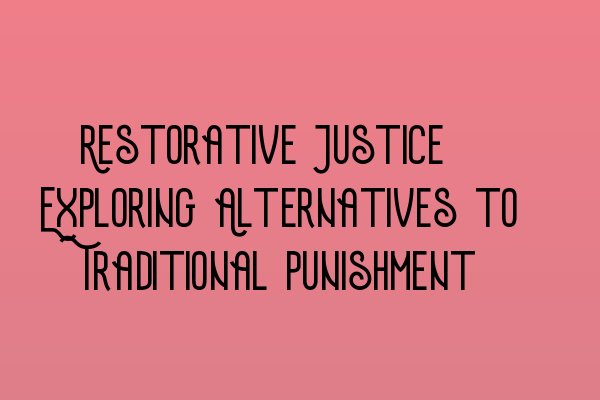Restorative Justice: Exploring Alternatives to Traditional Punishment
In the field of criminal law and practice, the concept of restorative justice has gained significant attention in recent years. Restorative justice offers an alternative approach to traditional punishment, focusing on repairing the harm caused by criminal behavior rather than simply imposing penalties. In this blog post, we will explore the principles of restorative justice and discuss its potential benefits and challenges.
What is Restorative Justice?
Restorative justice is a philosophy that aims to bring together the victims, offenders, and communities affected by a crime in a facilitated process. Instead of solely focusing on punishing the offender, restorative justice seeks to address the harms caused by the criminal act and promote healing and reconciliation.
The restorative justice process typically involves a structured dialogue between the victim and the offender, supervised by a trained facilitator. The dialogue allows both parties to express their feelings, discuss the impact of the crime, and find ways to repair the harm caused. It also provides an opportunity for the offender to take responsibility for their actions and make amends.
The Benefits of Restorative Justice
Restorative justice offers several potential benefits compared to traditional punishment methods:
- Victim Empowerment: Restorative justice places the victim at the center of the process, giving them a voice and an active role in seeking resolution. This can contribute to a sense of empowerment and healing for the victim.
- Offender Accountability: By involving the offender directly in the restorative process, it promotes accountability and encourages them to understand the consequences of their actions.
- Community Engagement: Restorative justice involves the community in addressing and resolving the harm caused by crime. This can help strengthen community bonds and promote a sense of collective responsibility.
- Reduced Recidivism: Research has shown that restorative justice programs can lead to lower rates of reoffending compared to traditional punitive measures. By addressing the underlying causes of criminal behavior, restorative justice aims to promote rehabilitation and prevent future crimes.
Challenges and Criticisms
While restorative justice has its merits, it is not without its challenges and criticisms. Some of the concerns raised include:
- Voluntary Participation: For restorative justice to be effective, all involved parties must willingly participate in the process. However, not all victims or offenders may be ready or willing to engage in dialogue.
- Power Imbalance: In cases where the harm caused is significant, there may be a power imbalance between the victim and the offender, making it difficult to achieve a truly restorative outcome.
- Resource Constraints: Restorative justice requires trained facilitators, adequate resources, and a supportive infrastructure. Implementation may be challenging in jurisdictions with limited funding or organizational capacity.
- Public Perception: Traditional punitive measures have long been ingrained in our criminal justice system, and shifting to restorative justice may face resistance from those who believe in a more punitive approach.
Conclusion
Restorative justice presents an alternative approach to punishment that focuses on repairing harm, fostering accountability, and promoting healing. While it has its challenges and critics, the potential benefits for victims, offenders, and communities warrant further exploration and consideration.
If you are interested in learning more about criminal law and practice in the UK, we recommend reading the following related articles:
- Legal Representation for Delaware LLCs in the UK: Expert Advice
- Ensuring Ethical Business Practices: Delaware’s Code of Conduct
- Legal Challenges for UK Businesses in the U.S.: Strategies for Overcoming Hurdles
- Legal Challenges for UK Businesses in the U.S.: Strategies for Overcoming Hurdles
- SQE Exam Prep: Essential Study Materials for Aspiring Solicitors
